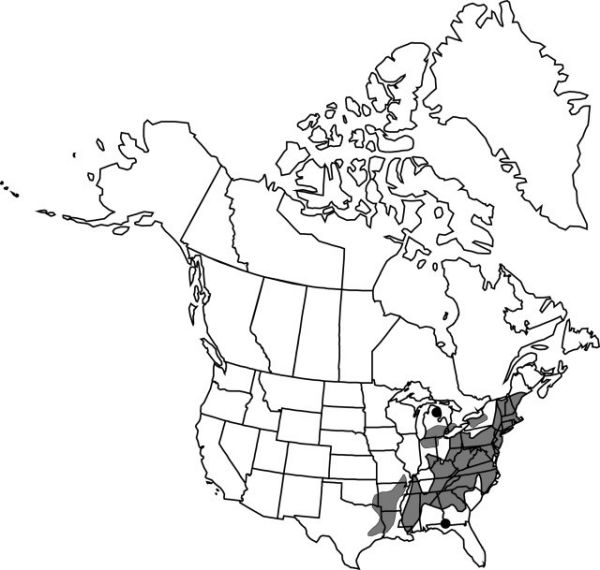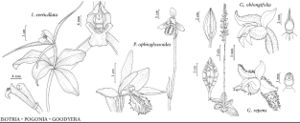Difference between revisions of "Isotria verticillata"
Med. Repos., hexade 2, 5: 357. 1808.
FNA>Volume Importer |
FNA>Volume Importer |
(No difference)
| |
Revision as of 21:38, 16 December 2019
Herbs, clonal, rhizomatous, 4–40 cm. Stems purplish to brownish green, glaucous; scales 2–4, typically below soil line, purplish. Leaves green adaxially; blade oblong-lanceolate, obovate, or elliptic, 25–100 × 10–53 mm, apex obtuse to acuminate, sometimes glaucous abaxially. Flowers pedunculate, showy, sweetly fragrant, without nectar; sepals spreading, purplish brown, narrowly lanceolate, 34–67 × 2–4 mm; petals yellowish green, elliptic-obovate to elliptic-lanceolate, 15–25 × 3–7 mm; lip yellowish green to white, streaked with purple, oblong, 15–25 × 8–9 mm, lateral lobes streaked with purple, margins involute, middle lobe rounded, margins revolute, undulate; callus green, longitudinal, fleshy; column 8–12 mm; ovary 20–30 mm; rostellar flap prominent. Capsules 20–42 × 5–10 mm; pedicel of mature capsule elongating to 20–55 mm. 2n = 18.
Phenology: Flowering Apr–Jun.
Habitat: Acidic soils, in dry to mesic forests, seeps, sphagnum bogs
Elevation: 10–2000 m
Distribution

Ont., Ala., Ark., Conn., Del., Fla., Ga., Ill., Ind., Ky., La., Maine, Md., Mass., Mich., Miss., Mo., N.H., N.J., N.Y., N.C., Ohio, Okla., Pa., R.I., S.C., Tenn., Tex., Vt., Va., W.Va.
Discussion
Isotria verticillata frequently forms extensive clones with hundreds of stems. It is pollinated by solitary bees of the Andrenidae, Anthophoridae, and Halictidae; plants are apparently self-compatible (L. A. Mehrhoff 1983). Nonflowering plants only rarely have a white, arrested floral bud (1–2 mm).
Selected References
None.
